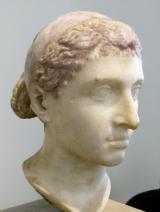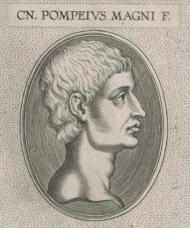誰がクレオパトラ7世とデートしましたか?
Gnaeus Pompeius Magnus 日付の クレオパトラ7世 ? から ?. まで
ガイウス・ユリウス・カエサル 日付の クレオパトラ7世 ? から ?. まで 年齢差は 30 年 6 か月 10 日.
クレオパトラ7世

クレオパトラ7世フィロパトル(ギリシア語: Κλεοπάτρα Ζ' Φιλοπάτωρ、ラテン語: Cleopatra VII Philopator、紀元前69年 - 紀元前30年)は、古代エジプトプトレマイオス朝ファラオ(女王)。
一般的に「クレオパトラ」と言えば彼女を指すことが多く、プトレマイオス朝の最後の女王で、ガイウス・ユリウス・カエサルやマルクス・アントニウスらとのロマンスで知られる。4人の子供を妊娠・出産した。有名なのはカエサルとのこ、カエサリオンである。王朝自体がアレクサンドロス3世の部下プトレマイオス1世による支配から始まったため、クレオパトラもギリシア系である。
「クレオパトラ」は、古代ギリシア語クレオパトロス(父の栄光)の女性形である。「絶世の美女」として知られ、世界三大美人の一人である。ただし、クレオパトラの肖像は治世当時、アントニウスが発行したとされている硬貨に横顔が残されているのみであり、この評価は後世の作り話だとの説がある(#人物節を参照)が、妹のアルシノエ4世の復元図から姉のクレオパトラも美しかったとする説もある。
なお、アレクサンドリアを襲った365年のクレタ地震のため、当時の史料は残っておらず、プルタルコスやスエトニウスら後世の歴史家による記録に負うが、その正確性には疑問が残る。
続きを読む...Gnaeus Pompeius Magnus

Cneo Pompeyo el Joven (75 a. C. - 45 a. C.), político y general romano de finales de la etapa republicana (siglo I a. C.).
続きを読む...クレオパトラ7世

ガイウス・ユリウス・カエサル

Gaius Julius Caesar (12 or 13 July 100 BC – 15 March 44 BC) was a Roman general and statesman. A member of the First Triumvirate, Caesar led the Roman armies in the Gallic Wars before defeating his political rival Pompey in a civil war. He subsequently became dictator from 49 BC until his assassination in 44 BC. Caesar played a critical role in the events that led to the demise of the Roman Republic and the rise of the Roman Empire.
In 60 BC, Caesar, Crassus, and Pompey formed the First Triumvirate, an informal political alliance that dominated Roman politics for several years. Their attempts to amass political power were opposed by many in the Senate, among them Cato the Younger with the private support of Cicero. Caesar rose to become one of the most powerful politicians in the Roman Republic through a string of military victories in the Gallic Wars, completed by 51 BC, which greatly extended Roman territory. During this time, he both invaded Britain and built a bridge across the river Rhine. These achievements and the support of his veteran army threatened to eclipse the standing of Pompey. The alliance between Caesar and Pompey slowly broke down and, by 50 BC, Pompey had realigned himself with the Senate. With his command expiring and the Gallic Wars largely concluded, the Senate ordered Caesar to step down from his military command and return to Rome. In early January 49 BC, Caesar openly defied the Senate by crossing the Rubicon and marching towards Rome at the head of an army. This began Caesar's civil war, which he won, leaving him in a position of near-unchallenged power and influence in 45 BC.
After assuming control of government and pardoning many of his enemies, Caesar set upon a vigorous reform and building programme. He created the Julian calendar to replace the republican lunisolar calendar, reduced the size of the grain dole, settled his veterans in new overseas colonies, greatly increased the size of the Senate, and extended citizenship to communities in Spain and what is now northern Italy. In early 44 BC, he was proclaimed "dictator for life" (dictator perpetuo). Fearful of his power, domination of the state, and the possibility that he might make himself king, a group of senators led by Brutus and Cassius assassinated Caesar on the Ides of March (15 March) 44 BC. A new series of civil wars broke out and the constitutional government of the Republic was never fully restored. Caesar's great-nephew and adoptive heir Octavian, later known as Augustus, rose to sole power after defeating his opponents thirteen years later. Octavian then set about solidifying his power, transforming the Republic into the Roman Empire.
Caesar was an accomplished author and historian; much of his life is known from his own accounts of his military campaigns. Other contemporary sources include the letters and speeches of Cicero and the historical writings of Sallust. Later biographies of Caesar by Suetonius and Plutarch are also important sources. Caesar is considered by many historians to be one of the greatest military commanders in history. His cognomen was subsequently adopted as a synonym for "emperor"; the title "Caesar" was used throughout the Roman Empire, and gave rise to modern descendants such as Kaiser and Tsar. He has frequently appeared in literary and artistic works.
続きを読む...